By Timothy G. Yan
For the last few decades, the American 5.56x45mm and the Russian 5.45x39mm has dominated the small-caliber high-velocity (SCHV) rifle ammunition of the world. Surprisingly, in the mid-1990s, the Chinese military introduced a new indigenous 5.8x42mm SCHV assault rifle round of their own. Like the Russians, the advantages of SCHV assault rifle ammo observed in Vietnam War battle reports did not go unnoticed by the Chinese military. In March, 1971, the Chinese military logistic department commenced a small arms research meeting known as the “713 Conference” in Beijing to develop the design criteria for an indigenous SCHV assault rifle cartridge. The design criteria called for a cartridge of approximately 6mm caliber, 1,000 meters per second muzzle velocity with the goals of reducing recoil and ammo weight while improving accuracy and terminal ballistics over the Type 56/M43 7.62x39mm full-caliber intermediate round. The following “744 Conference” narrowed down the calibers under consideration to 5.8mm and 6mm caliber. The cartridge case was to be selected from seven designs with overall cartridge lengths ranging from 56mm to 59.5mm. However, the new small caliber cartridge development was mostly a “paper project” for the initial eight years. The actual initiation of the project didn’t begin until late 1978 after most of the Cultural Revolution turmoil had died down. By 1979, the 5.8mm caliber and the 42mm case were chosen as the final design for the new SCHV round. The project completed its development in 1987 and the new SCHV assault rifle cartridge was officially designated as the DBP87.
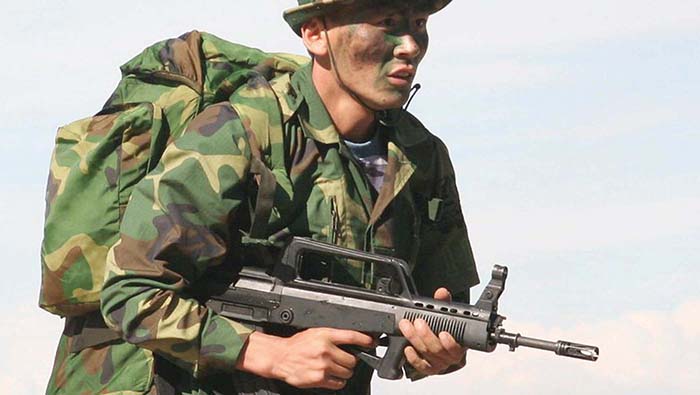
(Photo courtesy of ERNA Organization, www.erna.ee)
Shortly afterward, in 1988, Chinese small arms engineers started work on a long-range heavy load version of the 5.8mm cartridge to be used with the corresponding developments of a 5.8mm sniper rifle and 5.8mm lightweight General-Purpose Machine Gun (GPMG). The 5.8mm heavy load variant was created as a replacement for the obsolescent Type 53/Mosin-Nagant 7.62x54R rimmed full power cartridge. Development of the 5.8mm heavy load cartridge was completed in 1995.
The Chinese military has since developed a variety of small arms chambered for the new 5.8mm cartridge. The first was the QBZ87 assault rifle, an updated Type 81 chambered for the new 5.8mm round, was primarily used as the test bed for further 5.8mm ammo development. Next came the QBZ95 assault rifle family comprised of the QBZ95 assault rifle, QBB95 squad automatic rifle/light machine gun and the QBZ95B carbine. The QBZ95 (Qing, Bu-Qiang, Zi-Dong, 1995 Si or Infantry Rifle, Automatic, Model 1995) is a modern looking 7.1 pound (3.25kg) assault rifle in a “bullpup” configuration. The QBU88 sniper rifle, also a bullpup, became available in 1997. A lightweight belt-fed general-purpose machine gun known as the QJY88 was also developed. Both the sniper and the lightweight GPMG were specifically designed for the 5.8mm heavy load cartridge but were also backward compatible with standard 5.8mm rifle ammo. Recently another member of the 5.8mm weapon appeared as the QBZ03 assault rifle. Instead of the bullpup layout, the QBZ03 is in the “traditional” configuration with its magazine and action in front of the trigger and pistol grip like the American M16.
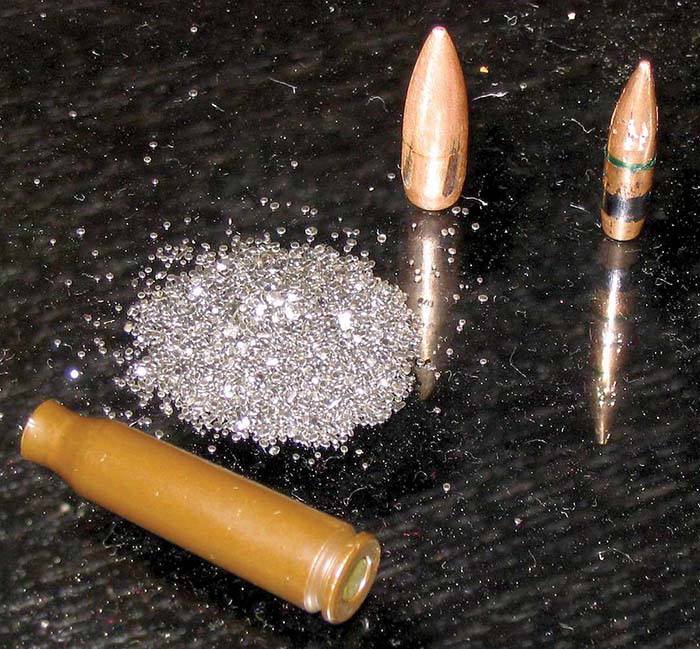
The 5.8mm standard rifle load has a 64 grain (4.15g) bullet with a full metal jacket made of steel and copper-washed coating. The 24.2mm long projectile has a very streamlined external shape with a sharp bullet ogive and a sizeable boat-tail. The 5.8mm bullet has a composite core that consists of a pin shaped hardened steel penetrator located near the base of the bullet, with lead as the filling material between the penetrator and the jacket as well as the tip cavity. The steel penetrator is 16mm in length, 4mm in diameter, and weighs 23 grains (1.5g).
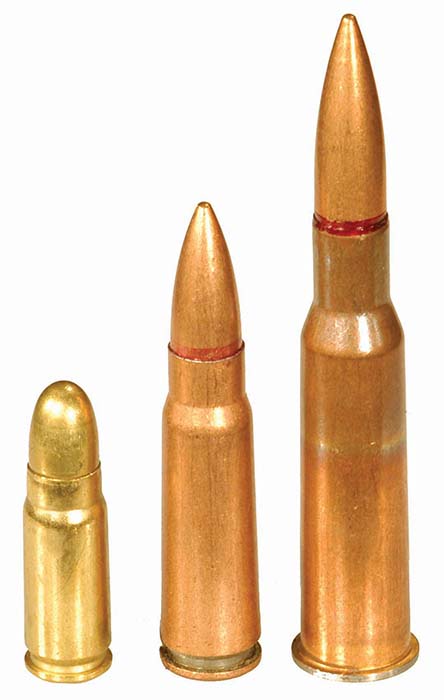
The new 5.8mm caliber will be eventually replacing all three 7.62mm rounds currently in service with the Chinese military. Variants of the 5.8x42mm will replace the 7.62x39mm in the center and the 7.62x54R at the right. The 7.62x25mm at the left will be replaced by a new 5.8x21mm pistol and submachine gun round. (Photo courtesy of David M. Fortier) 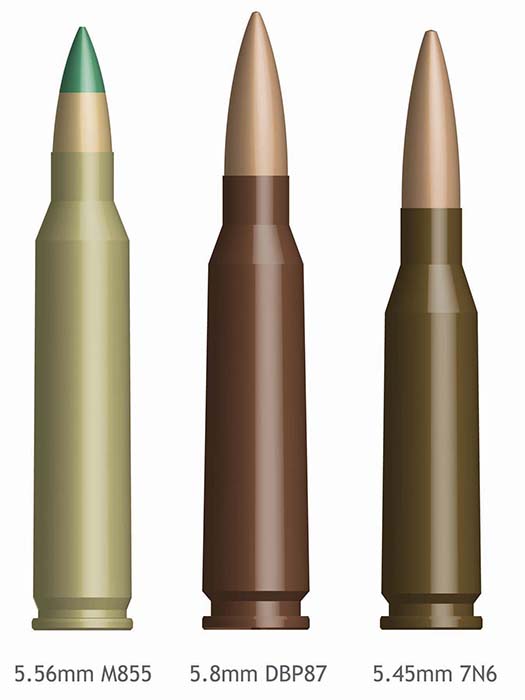
he side profile illustration of three current small-caliber high-velocity rifle rounds of the world. (Special thanks to Anthony G. Williams for providing the reference)
The 5.8mm heavy load has a completely different bullet design than that of the standard rifle load. Its bullet features a slightly smaller hardened steel penetrator at the tip of the bullet. This allows the use of more lead to increase the bullet’s mass and the front penetrator acts as a ballistic tip to help in attaining a higher ballistic coefficient for the 5.8mm heavy load. The overall bullet length is a little longer with a marginally rounder bullet ogive and a deeper boat-tail to improve aerodynamics in the near-subsonic velocity range. The bullet weight is increased to 77 grains (5g).
The 5.8mm cartridge has a 42mm long case with a 1 degree taper in the body from its 10.5mm diameter base. The bottle-neck shoulder and the neck are both 4mm long. The tapered case design also helps both ammo feeding and extraction. However, the straight wall case design of the 5.56mm has better accuracy. Steel is used as the primary material for the 5.8mm case likely because of the cost. The steel case is less expensive and lighter than the brass case of the 5.56mm but it requires extra corrosion protection in the form of a brownish color lacquer coating, which causes many other problems in itself. A harder and more brittle metal, steel tends to form a less than perfect seal in the chamber and more easily develops case ruptures that could lead to weapon malfunction. To ensure high extraction reliability, the 5.8mm case has a thick rim and a good size extractor groove.
The 5.8mm cartridge uses a silvery dual-base propellant in small dish shaped pellets. The propellant load is approximately 28 grains (1.8g), which is more than the 5.56mm’s 26 grains (1.7g) and the 5.45mm’s 25 grains (1.6g). Due to cost cutting measures, the 5.8mm’s propellant is of the corrosive powder variety. In contrast, NATO and other western nations have not used corrosive propellant since the end of World War II. The 5.8mm’s corrosive powder is not particularly hot either. It only generates a 41,500 psi (284 MPa) chamber pressure which is marginally higher than that of the old single-base propellant used by the vintage 7.62x39mm and much lower than the 5.56mm M855/SS109’s 55,000 psi (380 MPa). A non-reloadable Berdan primer is used to prime the 5.8mm cartridge’s propellant.
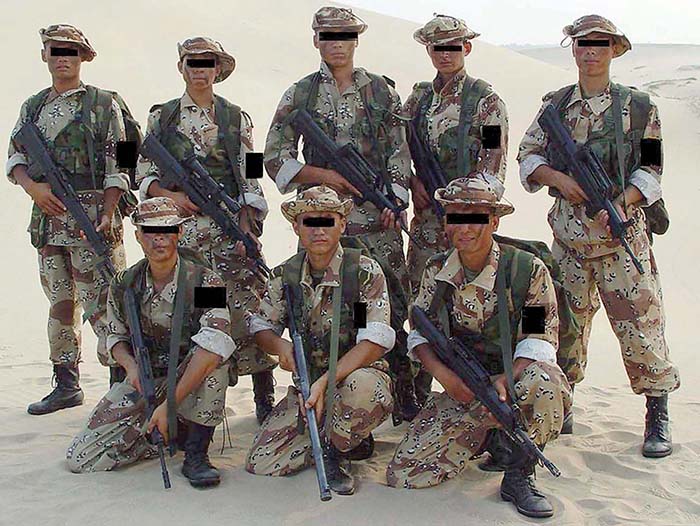
Chinese ammo designers claim the 5.8mm cartridge outperforms both the 5.56mm and 5.45mm in ballistics and penetration. The 5.8mm has more muzzle velocity and energy, a flatter trajectory with better velocity and energy retention down range.
The 5.8mm and the 5.56mm have similar ballistic performances out to 400 meter range. After 400 meters the 5.8mm with its superior ballistic coefficient moves ahead. The 5.45mm cartridge and the 5.56mm fired from the short barrel of the M4 carbine are simply no match for 5.8mm’s ballistics. The 5.8mm heavy load and the Mk262 5.56mm cartridge have roughly the same ballistic coefficient but the 5.8mm heavy load’s higher muzzle velocity gives it a higher velocity across the board. Both of these heavier bullets lose their velocity much slower than their lighter assault rifle counterparts.
The author had the opportunity to shoot the QBZ95 with the 5.8mm standard load, achieving an average 3 MOA (minute of angle) grouping at 100 meters. With a shooter more comfortable with the bullpup layout and a proper zero, a 2.5 MOA or better accuracy should be achievable with the same 5.8mm ammo and rifle combination. From my experience in the Marine Corps, the M855/SS109 5.56mm round has an average 2 MOA or better accuracy when fired from the M16A2. The newer M16A4 with its heavier and higher quality barrel should be even more accurate. The AK-74 and 7N6 5.45mm pairing can do 2.5-3 MOA up to 300 meters but the accuracy deteriorates rapidly once past 300 meters. The 5.8mm heavy load fired from the QBU88 sniper rifle is claimed to be capable of 1.2 MOA grouping at 100 meters. In actual service, the QBU88’s accuracy is around 1.5-1.6 MOA with non-match-grade regular 5.8mm heavy load ammo. In comparison, the United States Marine Corps’ (USMC) new M16A4 SAM-R (Squad Advanced Marksman Rifle) can easily achieve sub-MOA accuracy when using the Mk262 5.56mm ammo. As a whole, the 5.8mm’s accuracy is a substantial improvement over the older 7.62x39mm cartridge. Furthermore, it beats out the 1970’s era 5.45mm and approaches the accuracy of the 5.56mm and M16A2/A4 combination.
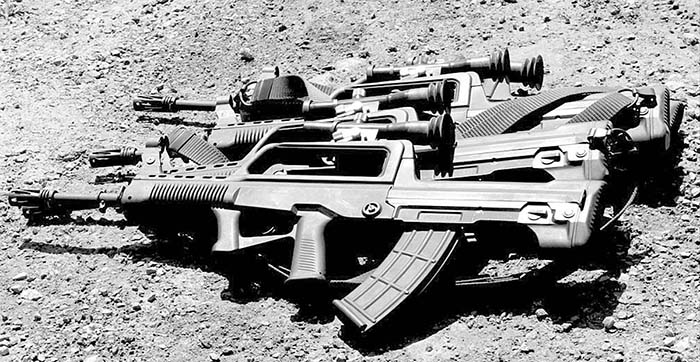
Information on the 5.8mm ballistic test was published in the August, 2003 issue of Small Arms, a Chinese language gun enthusiast magazine from mainland China. Additional test data was available from American small arms writer David M. Fortier’s research. The results of hard and soft target tests are shown in the charts.
The first three tests demonstrated the 5.8mm indeed out-penetrates both the 5.56mm and the 5.45mm as Chinese engineers stated. However, the test was manipulated to make the 5.8mm look good. A long-barrel QBB95 squad automatic rifle was used instead of the QBZ95 assault rifle for the test. The 5.8mm rounds fired from the QBB95 have a 164 feet per second (50m/s) muzzle velocity advantage over the 5.56mm fired from the Fabrique Nationale FNC assault rifle. Nevertheless, the 5.8mm’s 100% penetration rate of the 10mm steel plate at 300 meters is very impressive.
Realistically, the penetration performance difference between the 5.56mm and the 5.8mm is much closer. Contrary to the rigged Chinese ballistic test, unbiased tests done by the USMC and US Army’s Aberdeen Proving Ground show the 5.56mm M855/SS109 fired from the M16A2 rifle with the longer 20-inch (508mm) barrel has no problem penetrating the 3.5mm A3 steel test plate at 700 meters. Even so, the 5.8mm is still a better AP round than the 5.56mm. The 5.8mm bullet’s construction resembles the APHC (Armor-Piercing Hard Core) projectile design more common to dedicated AP ammo. The 5.8mm penetrates better because it was designed like AP ammo to begin with. The only known AP performance data of the 5.8mm heavy load is that it penetrates 15mm of mild steel at 85 meters and 1.3mm of hardened steel at 1,000 meters. The 5.8mm heavy load is said to out-penetrate the old 7.62x54R at any range. Many official and unofficial Chinese sources frequently mention how important the 5.8mm’s AP performance is. One possible explanation for the Chinese obsession with AP performance is that the 5.8mm’s AP ammo-like core was specially designed for use against opponents that are wearing heavy body armor – like the US forces.
Like most AP ammo, the test showed the 5.8mm bullet left a rather unimpressive wound cavity in the ballistic soap block. The 5.8mm’s wound cavity is one-third smaller than that of the 5.56mm’s and close to one-half smaller than the 5.45mm’s cavity. The thick steel jacket and the absence of a cannelure on the 5.8mm bullet prevent any fragmentation. The more balanced weight distribution of the solid lead tip with the steel core in the back also prevents the 5.8mm bullet from tumbling early and erratically. Nevertheless, Chinese sources claim the 5.8mm has 60 percent increase in lethality over the old 7.62x39mm it replaces.
How will the 5.8mm perform in combat? According to China’s Xinhua news agency, the 5.8mm round scored its first combat kill recently in Haiti during a firefight between Chinese United Nations peacekeepers and the local rebels. The performance of the 5.8mm in urban combat operation will likely be a mixed bag. On one hand, its superb penetration will be suitable for punching through tactical obstacles like brick wall, metal doors, automobile bodies, and masonry debris. On the other hand, the 5.8mm’s unimpressive terminal ballistics may require multiple hits to neutralize an opponent. The 5.8mm will fair better in open environments like desert and mountainous terrain with its longer effective range.
The 5.8mm heavy load may look good as an extended range small caliber rifle round, but as the replacement for the full-caliber high power 7.62x54R it is a miserable failure. It is just physically impossible for the SCHV round to produce anything close to the same amount of hitting power and bullet energy as the larger 7.62mm caliber. This is probably the main reason why the Chinese military didn’t want the 5.8mm general-purpose machine gun. The claim of the 5.8mm heavy load out-penetrating the 7.62mm is true but misleading. The higher penetration comes solely from the 5.8mm’s hardened steel penetrator that the all-lead core 7.62mm lacks.
I would like to acknowledge Capt. Stephen Miles, USA, Zhang Yuxing, David M. Fortier, Anthony G. Williams, Stanly Crist and Jon Cohen for their generous help.
DBP87 Specifications
Caliber: 5.8x42mm
Overall Length: 58mm
Total Weight: 192.5 grains (12.5 grams)
Cartridge Case Length: 42mm
Cartridge Case Taper: 1 degree
Cartridge Case Base Diameter: 10.5mm
Cartridge Case Material: Steel with Lacquer Coating
Propellant: Dual-based corrosive powder t type
Propellant Weight: 28 grains (1.8 grams)
Primer: Berdan Type
Projectile Type: FMJ-BT, Composite Core
Projectile Diameter: Approximately 6mm
Projectile Length: 24.2mm
Projectile Weight: Standard Rifle Load – 64 grains (4.15 grams), Heavy Load – 77 grains (5 grams)
Penetrator Material: Hardened Steel
Penetrator Length: 16mm
Penetrator Diameter: 4mm
Penetrator Weight: 23 grains (1.5 grams)
Muzzle Velocity: Assault Rifle – 3,050 fps (930m/s),
Squad Automatic Rifle – 3,181 fps (970m/s),
Carbine – 2,581 fps (790m/s),
Sniper Rifle and GPMG – 2,936 fps (895/s)
Status: In service with all branches of People’s Liberation Army of China, People’s Armed Police of China (Paramilitary), and the Chinese Police Forces.
| This article first appeared in Small Arms Review V9N9 (June 2006) |











